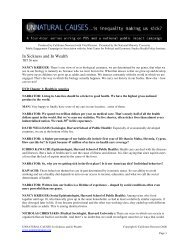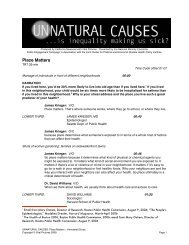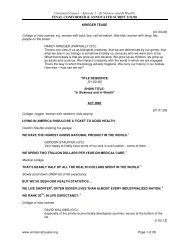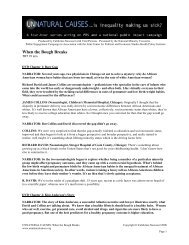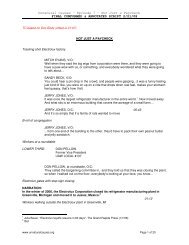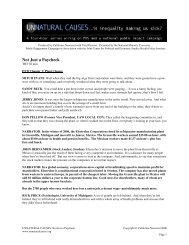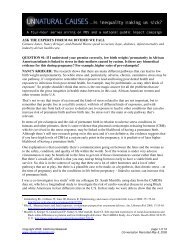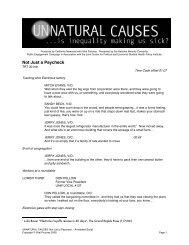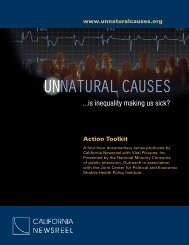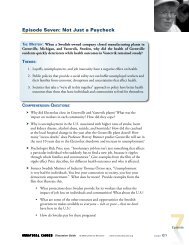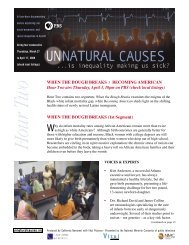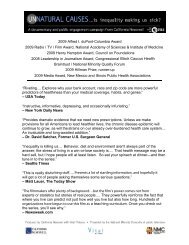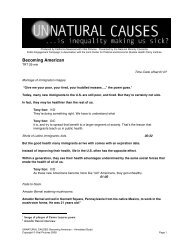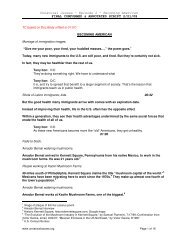Episode 1: In Sickness & in Wealth - Unnatural Causes
Episode 1: In Sickness & in Wealth - Unnatural Causes
Episode 1: In Sickness & in Wealth - Unnatural Causes
Create successful ePaper yourself
Turn your PDF publications into a flip-book with our unique Google optimized e-Paper software.
<strong>Episode</strong> 1: <strong>In</strong> <strong>Sickness</strong> & <strong>in</strong> <strong>Wealth</strong><br />
Th e My s t e ry: Given our wealth and medical advances, why does<br />
the United States rank 29th <strong>in</strong> the world for life expectancy (as of<br />
December 2007) What are the connections between healthy bodies<br />
and healthy bank accounts and race / ethnicity<br />
Th e m e s:<br />
1. Class status correlates with health outcomes:<br />
a. Our economic, social and built environments shape health<br />
b. People who are middle to lower on the class pyramid are<br />
exposed to more health threats (material deprivation to<br />
chronic stressors) and have less access to the opportunities<br />
and resources needed to control their dest<strong>in</strong>ies.<br />
c. People middle to higher on the class pyramid have access<br />
to more power and resources and <strong>in</strong> general live longer,<br />
healthier lives. This is true not only for the bottom and<br />
top but at every level.<br />
d. Chronic activation of the body’s stress response wears<br />
down our organs over time and <strong>in</strong>creases disease risk.<br />
2. Racism also threatens health, both “upstream” and <strong>in</strong>dependent<br />
of class. At every <strong>in</strong>come level, African Americans, Pacific<br />
Islanders, Native Americans and other people of color often fare<br />
worse than their white counterparts.<br />
3. Social and economic policies have reduced health <strong>in</strong>equities <strong>in</strong><br />
the past and <strong>in</strong> other countries.<br />
Co m p r e h e n s i o n Qu e s t i o n s:<br />
What did the Whitehall study reveal about the connection<br />
between health and wealth What is the wealth-health gradient<br />
Dr. David Williams says: “Stress helps motivate us. <strong>In</strong> our society<br />
today everybody experiences stress. The person who has no<br />
stress is a person who is dead.” Describe the body’s stress (fightor-flight)<br />
response. How is chronic stress different How might<br />
chronic stress <strong>in</strong>crease the risk of illness and disease<br />
How do the lives of Jim Taylor, Tondra Young, Corey Anderson<br />
and Mary Turner exemplify concepts like the wealth-health<br />
gradient and the importance of power and control What does<br />
compar<strong>in</strong>g data maps of disease rates <strong>in</strong> the different Louisville<br />
council districts reveal What might expla<strong>in</strong> observed differences<br />
<strong>Episode</strong><br />
<strong>Unnatural</strong> <strong>Causes</strong> Discussion Guide © 2008 California Newsreel www.unnaturalcauses.org<br />
page A1
Professor Leonard Syme def<strong>in</strong>es control of dest<strong>in</strong>y as the “ability to <strong>in</strong>fluence<br />
the events that imp<strong>in</strong>ge on your life.” Why is this ability an important factor<br />
for health<br />
• What stories from Corey Anderson’s life exemplify a high demand / low<br />
control job and stressful home situation<br />
• What stories from Jim Taylor’s life illustrate how wealth, power and status<br />
translate <strong>in</strong>to better health<br />
What did the Macaque monkey research teach primatologist Carol Shively about<br />
the connections between power, subord<strong>in</strong>ation and health What parallels can we<br />
draw to human society<br />
Describe examples from the film that illustrate how racism imposes an additional<br />
health burden on people of color. Give examples of both “everyday” racism<br />
(be<strong>in</strong>g treated unfairly) and “structural” racism (access to resources, power, status<br />
and wealth) and describe how these might affect health <strong>in</strong> different ways.<br />
What social changes were most responsible for the 30-year <strong>in</strong>crease <strong>in</strong> American<br />
life expectancy over the 20th century What policies does the film po<strong>in</strong>t to that<br />
might account for our low rank <strong>in</strong> recent years compared to other countries<br />
(29th as of December 2007) What characterizes the policies and priorities of<br />
countries that have better health outcomes than we do<br />
Di s c u s s i o n Qu e s t i o n s:<br />
Dr. Adewale Troutman says that he promotes <strong>in</strong>dividual responsibility, but<br />
always with<strong>in</strong> the context of social determ<strong>in</strong>ants. Why does he l<strong>in</strong>k the two<br />
What is miss<strong>in</strong>g if we focus exclusively on <strong>in</strong>dividual responsibility How does<br />
this affect possibilities for change<br />
Dr. Ichiro Kawachi observes that the ability to avoid smok<strong>in</strong>g and eat a healthy<br />
diet depends on access to “<strong>in</strong>come, education, and the social determ<strong>in</strong>ants of<br />
health.” Do conditions <strong>in</strong> your community promote or h<strong>in</strong>der healthy choices<br />
What policies shape those conditions<br />
Angelique Anderson says: “I always wanted to have a house with a big back<br />
yard...” Corey adds: “I want to own a house so that if anyth<strong>in</strong>g happened to me,<br />
she wouldn’t be put out on the street.”<br />
• What health benefits might derive from affordable, quality and secure<br />
hous<strong>in</strong>g<br />
• How does home ownership (or its lack) affect conditions <strong>in</strong> your<br />
community<br />
• How easy or difficult is it to f<strong>in</strong>d quality, affordable hous<strong>in</strong>g <strong>in</strong><br />
your community<br />
<strong>Episode</strong><br />
<strong>Unnatural</strong> <strong>Causes</strong> Discussion Guide © 2008 California Newsreel www.unnaturalcauses.org<br />
page A2
Some chronic stressors mentioned <strong>in</strong> the film are: be<strong>in</strong>g on guard<br />
all the time, hav<strong>in</strong>g little control at work, liv<strong>in</strong>g <strong>in</strong> an unsafe<br />
neighborhood, be<strong>in</strong>g uncerta<strong>in</strong> about where food will come<br />
from, and worry<strong>in</strong>g about one’s children.<br />
• What additional stressors can you th<strong>in</strong>k of<br />
• How does exposures to stressors—and resources available<br />
to manage them—vary with class position<br />
• Describe the societal forces that create and re<strong>in</strong>force<br />
these stressors.<br />
• What additional set of stressors might racism impose<br />
Dr. Troutman says: “There’s almost a cultural demarcation <strong>in</strong><br />
the city where on one side of this particular street, N<strong>in</strong>th Street,<br />
there’s a tremendous amount of new development go<strong>in</strong>g on,<br />
condos ris<strong>in</strong>g up….And right across the street is where the public<br />
hous<strong>in</strong>g projects beg<strong>in</strong>…. Every city has a N<strong>in</strong>th Street.”<br />
• Where is the N<strong>in</strong>th Street, the divid<strong>in</strong>g l<strong>in</strong>e, <strong>in</strong> your city<br />
or area<br />
• How would you characterize either side of the l<strong>in</strong>e List<br />
and compare the health promoters and health threats.<br />
• Who lives there and who doesn’t Why<br />
• Were these areas different <strong>in</strong> the past What government,<br />
land use, development and other <strong>in</strong>vestment decisions<br />
changed them<br />
Dr. Jack Shonkoff, when talk<strong>in</strong>g about early childhood, says,<br />
“The concept here is the pile-up of risk, the cumulative burden<br />
of hav<strong>in</strong>g th<strong>in</strong>gs that are <strong>in</strong>creas<strong>in</strong>g your chances of hav<strong>in</strong>g<br />
problems, as opposed to the cumulative protection of hav<strong>in</strong>g<br />
th<strong>in</strong>gs <strong>in</strong> your life that <strong>in</strong>crease the likelihood that you can<br />
have better outcomes.” What are examples of the “pile up” of<br />
cumulative advantage—and disadvantage<br />
• Sociologist David Williams say, “Economic policy is<br />
health policy.” How has U.S. <strong>in</strong>fluenced health <strong>in</strong>equities<br />
and health outcomes What k<strong>in</strong>ds of economic policies<br />
might reduce health <strong>in</strong>equities and improve the overall<br />
health of most Americans<br />
<strong>Episode</strong><br />
<strong>Unnatural</strong> <strong>Causes</strong> Discussion Guide © 2008 California Newsreel www.unnaturalcauses.org<br />
page A3
The film notes that sweep<strong>in</strong>g social reforms made dur<strong>in</strong>g the<br />
Progressive Era, the New Deal, and the Civil Rights Movement<br />
improved population health.<br />
• Why would changes that promote greater equity translate<br />
<strong>in</strong>to population health improvements<br />
• What do you notice about whether those policies or<br />
programs emphasized medical advances, greater <strong>in</strong>dividual<br />
responsibility, new programs and services, or structural<br />
and social change<br />
• Should know<strong>in</strong>g about the health effects of social policies<br />
change the value that Americans place on these k<strong>in</strong>ds of<br />
policies Why or why not<br />
Whitehall study director Sir Michael Marmot says, “If <strong>in</strong>equalities<br />
<strong>in</strong> health were a fixed property of society, then you’d say, ‘We can’t<br />
do anyth<strong>in</strong>g about it.’ But that’s not the case. The magnitude of<br />
<strong>in</strong>equalities <strong>in</strong> health changes over time. It can get rapidly worse,<br />
and if it can get rapidly worse, it ought to be possible to make it<br />
rapidly better.” Describe how the policies below might promote<br />
better health for everyone. What other policies or social changes<br />
might you add to this list:<br />
Exist<strong>in</strong>g:<br />
8-hour work day<br />
M<strong>in</strong>imum wage<br />
Unemployment <strong>in</strong>surance<br />
Free K-12 public education<br />
Affirmative action (limited)<br />
Social security<br />
Potential:<br />
Guaranteed paid vacation<br />
Liv<strong>in</strong>g wage<br />
Job tra<strong>in</strong><strong>in</strong>g and placement<br />
Paid parental leave<br />
Hous<strong>in</strong>g assistance<br />
Universal health care<br />
What k<strong>in</strong>ds of employment, education, hous<strong>in</strong>g, or<br />
transportation polices do we need today to promote health<br />
equity What obstacles and opportunities exist How are<br />
strategies for social change different than programs for repair<strong>in</strong>g<br />
damage How would power have to shift What does that mean<br />
<strong>Episode</strong><br />
<strong>Unnatural</strong> <strong>Causes</strong> Discussion Guide © 2008 California Newsreel www.unnaturalcauses.org<br />
page A4
Su g g e s t e d Ac t i v i t y: Ma p p i n g Co m m u n i ty As s e t s<br />
This activity helps participants identify sources of stress and support <strong>in</strong> their lives and<br />
th<strong>in</strong>k about ways they might <strong>in</strong>crease their level of power and control.<br />
1. The follow<strong>in</strong>g chart lists areas that are potentially positive or negative <strong>in</strong> people’s<br />
lives, depend<strong>in</strong>g on their circumstances. As a group or <strong>in</strong>dividually, have<br />
participants th<strong>in</strong>k about each topic, decide whether it is a health threat and<br />
stressor or a resource <strong>in</strong> their life/community and expla<strong>in</strong> why. Note: there may<br />
be multiple, even contradictory, answers per topic. (NOTE: This activity can<br />
also be adapted for use <strong>in</strong> and around workplace and labor policy issues)<br />
RESOURCES<br />
STRESSORS<br />
Food Access and Availability<br />
Quality Education<br />
Good Transportation / Plann<strong>in</strong>g<br />
Affordable Hous<strong>in</strong>g<br />
Good Jobs & Work Opportunities<br />
Bus<strong>in</strong>ess <strong>In</strong>vestment and Development<br />
<strong>In</strong>come and <strong>Wealth</strong><br />
Social Supports<br />
Public Safety<br />
Green Spaces<br />
Recreational Opportunities<br />
(We recommend copy<strong>in</strong>g this diagram onto a blackboard or creat<strong>in</strong>g your own handout<br />
based on these or your own categories. See the UNNATURAL CAUSES Policy Guide for<br />
other suggestions).<br />
2. As a group, ask participants to share thoughts about the results. What patterns<br />
do you observe How do neighbor<strong>in</strong>g communities compare How do you feel<br />
about this snapshot of your life or community What does it fail to capture<br />
<strong>Episode</strong><br />
<strong>Unnatural</strong> <strong>Causes</strong> Discussion Guide © 2008 California Newsreel www.unnaturalcauses.org<br />
page A5
3. Together, pick a few stressors and health threats to discuss. Bra<strong>in</strong>storm<br />
ideas for how each might be turned <strong>in</strong>to a resource, <strong>in</strong>clud<strong>in</strong>g how you<br />
might use exist<strong>in</strong>g resources <strong>in</strong> other areas to accomplish this. What<br />
challenges might surface What policy arenas need to be engaged What<br />
opportunities exist for mobiliz<strong>in</strong>g people <strong>in</strong>to action<br />
4. Turn<strong>in</strong>g your attention to exist<strong>in</strong>g resources, pick a few and ask, what<br />
makes the existence of these resources possible What might threaten<br />
them How can they be susta<strong>in</strong>ed or further developed What policies and<br />
/ or political action might strengthen and protect them<br />
5. Before end<strong>in</strong>g the activity, solicit suggestions from the group about next<br />
steps and further actions that can be taken. Depend<strong>in</strong>g on the read<strong>in</strong>ess of<br />
your group, these might even take the form of guid<strong>in</strong>g pr<strong>in</strong>ciples or goals,<br />
such as the recommendations Dr. Troutman makes <strong>in</strong> the film:<br />
• Encourage economic development <strong>in</strong> low-<strong>in</strong>come neighborhoods<br />
• Use zon<strong>in</strong>g laws to restrict fast-food outlets and encourage grocery<br />
stores <strong>in</strong> low-<strong>in</strong>come neighborhoods<br />
• Improve routes and reliability of public transportation<br />
• Create more equitable school f<strong>in</strong>anc<strong>in</strong>g formulas<br />
• Construct quality low-cost hous<strong>in</strong>g <strong>in</strong> <strong>in</strong>tegrated, mixed <strong>in</strong>come<br />
neighborhoods<br />
We b Si t e Ti p s:<br />
Onl<strong>in</strong>e Activity: Explore YOYO Health to see how the U.S. compares with other<br />
countries on a number of key <strong>in</strong>dicators.<br />
Onl<strong>in</strong>e Activity: Test your knowledge with our Health Equity Quiz!<br />
Resource: See how socioeconomic status and health outcomes are distributed<br />
across four Louisville Council Districts <strong>in</strong> Mapp<strong>in</strong>g Health and <strong>In</strong>equity across<br />
Louisville (PDF) <strong>in</strong> our Health Equity database.<br />
<strong>Episode</strong><br />
<strong>Unnatural</strong> <strong>Causes</strong> Discussion Guide © 2008 California Newsreel www.unnaturalcauses.org<br />
page A6
Ke y Re f e r e n c e s:<br />
Cohen, S., J.E. Schwartz, E. Epel, C. Kirschbaum, S. Sidney, and T. Seeman. “Socioeconomic Status,<br />
Race, and Diurnal Cortisol Decl<strong>in</strong>e <strong>in</strong> the Coronary Artery Risk Development <strong>in</strong> Young Adults<br />
(CARDIA) Study,” Psychosomatic Medic<strong>in</strong>e, 68 (2006): 41-50.<br />
Daniels, Norman, Bruce P. Kennedy, and Ichiro Kawachi. “Why Justice Is Good for Our Health:<br />
The Social Determ<strong>in</strong>ants of Health <strong>In</strong>equalities,” Daedalus 128 no. 4 (1999): 215-251.<br />
Hofrichter, Richard, ed. Health and Social Justice: Politics, Ideology, and <strong>In</strong>equity <strong>in</strong> the Distribution of<br />
Disease. San Francisco: Jossey-Bass, 2003.<br />
House, J.S. and Williams, D.R. “Understand<strong>in</strong>g and Reduc<strong>in</strong>g Socioeconomic and Racial/Ethnic<br />
Disparities <strong>in</strong> Health” <strong>in</strong> Promot<strong>in</strong>g Health: <strong>In</strong>tervention Strategies from Social and Behavioral Research ed.<br />
B.D. Smedley & S.L. Syme, 81-124. Wash<strong>in</strong>gton, DC: National Academy of Sciences, 2000.<br />
Kubzansky, Laura D., Nancy Krieger, Ichiro Kawachi, Beverly Rockhill, Gillian K. Steel and Lisa<br />
Berkman. “Social <strong>In</strong>equality and the Burden of Poor Health” <strong>in</strong> Challeng<strong>in</strong>g <strong>In</strong>equities <strong>in</strong> Health: From<br />
Ethics to Action, ed. Timothy Evans et al. NY: Oxford, 2001.<br />
Marmot, Michael, G. Davey Smith et al. “Health <strong>In</strong>equalities among British Civil Servants: The<br />
Whitehall II Study,” Lancet 337 (1991): 1387-1393.<br />
Satcher, David, George E. Fryer, Jr., Jessica McCann, Adewale Troutman, Steven H. Woolf and George<br />
Rust. “What If We Were Equal A Comparison of the Black-White Mortality Gap <strong>in</strong> 1960 and 2000,”<br />
Health Affairs, 24 no. 2 (2005): 459-464.<br />
The Web site for Louisville’s Center for Health Equity (founded by Dr. Adewale Troutman) <strong>in</strong>cludes<br />
def<strong>in</strong>itions of key terms related to health equity and an excellent set of l<strong>in</strong>ks to national and<br />
<strong>in</strong>ternational health organizations: www.louisvilleky.gov/Health/equity/<br />
From the film:<br />
• Americans spend $2 trillion annually on medical care, nearly half of all health dollars spent<br />
<strong>in</strong> the world.<br />
• Among <strong>in</strong>dustrialized nations, the U.S. ranks 29th <strong>in</strong> life expectancy.<br />
• 47 million Americans have no health <strong>in</strong>surance.<br />
• <strong>In</strong> the U.S., the wealth of the top 1% is greater than the comb<strong>in</strong>ed wealth of the bottom 90%.<br />
• The majority of poor people <strong>in</strong> the U.S. are white.<br />
• A 2005 study revealed that each year, more than 83,000 preventable African American deaths<br />
are attributable to the Black-white mortality gap.<br />
• People who grew up <strong>in</strong> a house owned by their parents are less likely to get sick as adults<br />
when exposed to a cold virus.<br />
<strong>Episode</strong><br />
<strong>Unnatural</strong> <strong>Causes</strong> Discussion Guide © 2008 California Newsreel www.unnaturalcauses.org<br />
page A7



